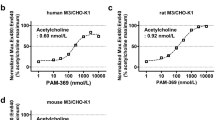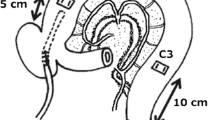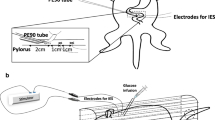Abstract
The colonic motor response to eating requires cholinergic transmission. Recent studies have identified two subclasses of muscarinic receptor, the M1 and the M2 subtype. The aim of this study was to evaluate the muscarinic receptor subtype responsible for mediating the gastrocolonic response. Spike potential (SP) activity and intraluminal pressure were recorded, during fasting and after eating a 1000-kcal mixed meal, from the distal colon of 10 healthy volunteers. In each subject three paired studies were carried out: either atropine (a nonselective antimuscarinic, 1 mg), pirenzepine (a selective M1 antimuscarinic, 10 mg), or saline were infused intravenously before eating, using a double-blind crossover design. The meal significantly increased colonic spike potential activity (17.6±3.9, SP/30 min) above fasting values (2.7±0.6,P<0.01) in the control study. There was no postprandial increase in spike potential activity (3.3±0.9, SP/30 min) after atropine. The meal also significantly increased spike potential activity (15.4±3.3 SP/30 min,P<0.01) above fasting levels and equal to that of the controls, in the pirenzepine study. These data suggest that the colonic motor response to eating is mediated through the M2 but not the M1 subtype of muscarinic receptors.
Similar content being viewed by others
References
Snape WJ, Wright SH, Battle WM, Cohen S: The gastrocolonic response: Evidence for a neural mechanism. Gastroenterology 77:1235–1240, 1979
Snape WJ, Matarazzo SA, Cohen S: Effect of eating and gastrointestinal hormones on human colonic myoelectrical and motor activity. Gastroenterology 75:373–378, 1978
Sullivan MA, Cohen S, Snape WJ: Colonic myoelectrical activity in the irritable bowel syndrome: Effect of eating and anticholinergics. N Eng J Med 298:878–883, 1978
Sun EA, Snape WJ, Cohen S, Renny A: The role of opiate receptors and cholinergic neurons in the gastrocolonic response. Gastroenterology 82:689–693, 1982
Goyal RK, Rattan S: Neurohumoral, hormonal, and drug receptors for the lower esophageal sphincter. Gastroenterology 74:598–619, 1978
Hammer R, Berrie CP, Birdsall NJM, Burgen ASV, Hulme EC: Pirenzepine distinguishes between different subclasses of muscarinic receptors. Nature 283:90–92, 1980
Feldman M: Inhibition of gastric acid secretion by selective and nonselective anticholinergics. Gastroenterology 86:361–366, 1984
Jaup BH: Studies on the mode of action of pirenzepine in man, with special references to its anticholinergic muscarinic properties. Scand J Gastroenterol 16(Suppl 68):1–26, 1981
Hammer R, Koss FW: The pharmacokinetic profile of pirenzepine. Scand J Gastroenterol 14(Suppl 57):1–6, 1979
Jaup BH, Stockbrugger RW, Dotevall G: Comparison of the pirenzepine andl-hyoscyamine on gastric secretion and other muscarinic effects. Scand J Gastroenterol 15(Suppl 66):89–94, 1980
Hammer R: Subclasses of muscarinic receptors and pirenzepine. Further experimental evidence. Scand J Gastroenterol 17(Suppl 72):59–67, 1982
Gilbert R, Rattan S, Goyal RK: Pharmacologic identification of muscarinic M1 and M2 receptor subtypes. Gastroenterology 84:1166, 1983
Stockbrugger RW, Jaup BH, Dotevall G: The effect of different doses of pirenzepine on gastric secretion stimulated by modified sham feeding in man. Scand J Gastroenterol 17(Suppl 72):111–116, 1981
Stockbrugger R, Jaup B, Hammer R, Dotevall G: Inhibition of gastric acid secretion by pirenzepine (LS 519) in man. Scand J Gastroenterol 14:615–620, 1979
Parsons E, Bunce T, Blakemore C, Rasmussen C: In Die Behandlung des ulcus pepticum mit pirenzepine. AL Blum, R Hammer (eds). Karl Demeter, Munich, 1979, pp 26–34
Jennewein HM:In Die Behandlung des ulcus pepticum pirenzepine. AL Blum, and R Hammer (eds). Karl Demeter, Munich, 1979, pp 41–48
Jaup BH, Dotevall G: The effect of pirenzepine on gastric emptying and salivary secretion in healthy volunteers. Scand J Gastroenterol 16:769–773, 1981
Jaup Bh, Stockbrugger RW, Dotevall G: Comparison between the effects of pirenzepine andl-hyoscyamine in man. Scand J Gastroenterol 17:119–122, 1981
Dent J, Bozler G, Heddle R, Barnes B, Lewis I: Evaluation of the selectivity of the antimuscarinic agent pirenzepine for inhibition of gastric secretion by comparison with atropine. Gastroenterology 84:1135, 1983
Jaup BH, Abrahamsson H, Virtanes R, Iisalo E: Effect of pirenzepine compared with atropine andl-hyoscyamine on esophageal peristaltic activity in humans. Scand J Gastroenterol 17:233–239, 1982
Author information
Authors and Affiliations
Rights and permissions
About this article
Cite this article
Narducci, F., Bassotti, G., Daniotti, S. et al. Identification of muscarinic receptor subtype mediating colonic response to eating. Digest Dis Sci 30, 124–128 (1985). https://doi.org/10.1007/BF01308197
Received:
Revised:
Accepted:
Issue Date:
DOI: https://doi.org/10.1007/BF01308197




